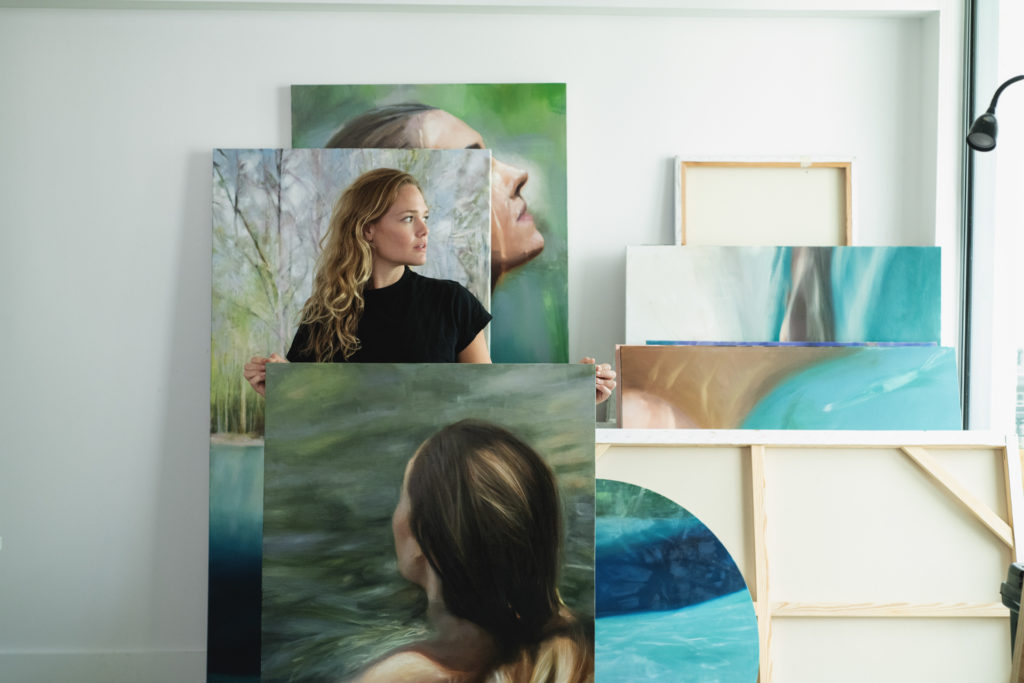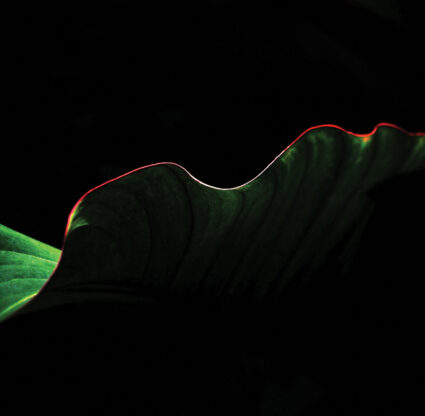“How can we exist in a way that’s fulfilling to our health and mind and bodies?” artist Reisha Perlmutter asks. “That’s the question my artwork aims to answer.” She paints women in and around bodies of water that range from Florida’s crystalline pools to the state’s ancient freshwater springs. Her eyes flicker with intensity as she stands by a palette encrusted with dried oil paint; her speech a steady stream, deliberate and bright.
Perlmutter, who now splits her time between Miami Beach and Brooklyn, grew up in Naples, captivated by the lush, subtropical environment. Her family grew their own food as part of a clean-living lifestyle prioritized by her father, the well-known nutritionist, Dr. David Perlmutter. “I grew up in a family that was very centered around nature and connecting with it,” she explains. Those early experiences, running wild outdoors and not glued to a screen, fueled her creative mind. “In my earliest memories, I can recall watching shadows from leaves dancing on my hands and having clear moments of realizing that the world around me was art,” she says.
Perlmutter made good on her girlhood observations and left to study art formally. After college, she spent a few months in France, copying masterpieces at the Louvre as part of an intensive program, and then returned stateside for her Masters of Fine Arts at the New York Academy of Art, where she graduated in 2015. Soon after, she had shoulder surgery and returned home to Naples to recover. She’d spend days floating in her family’s pool to alleviate her discomfort. Suspended in the water under the landscape that had captured her imagination as a child, she realized her sense of wonder had become buried under fears associated with adulthood. “It was the first time as an adult that I was able to fully recognize and connect the weight of nature and specifically water as it related to my sense of wonder as a child, and tie it to myself as an adult,” she says.
That’s when she found her voice as an artist. Back in New York, she began a series of realistic, representational oil paintings depicting women suspended in water. She became a proficient photographer, taking the reference photos of her subjects that she’d later paint; this included learning how to shoot underwater in her family’s pool on visits back to Naples. Perlmutter worked on her new series prolifically and exhibited the paintings locally at mainstays like Paul Arsenault’s former Third Street South gallery and Artis—Naples, The Baker Museum, as well as in New York City, the Hamptons, and at Miami art fairs.

From the onset, she was aware of a potential hurdle: the historical implications of painting young, nude women. For most of Western art history, women have frequently been portrayed as decorative, sexualized status symbols instead of autonomous individuals—think of Titian’s 1534 Venus of Urbino, with her plump, ivory body reclined and her fingers manipulatively composed. “I want to paint women who are empowered by their strength and bodies, not just sexualized,” she says. Perlmutter recognizes that she lives in a time and position where she can challenge those longstanding stereotypes. “I don’t take being a female artist lightly,” she says.
Whether her subjects gracefully float or athletically twist underwater, they’re in full control of themselves and their environment. In her 2016 self-portrait Dahlia, the figure floats upside down, her eyes gently closed as turquoise air bubbles emit from her nose. Everything about the scene is serene; the subject is almost angelically asleep, oblivious to the outside world or its judgments. Her 2018 painting, Spinel, is even more overt in its subject’s self-confidence: a dark-haired woman stands nude on a pristine beach, jaw slightly lifted, baring a bright white scar that runs down her sternum, the remnant of major cardiac surgery. She exposes her scar to the empty sands around her, her peaceful, self-possessed expression speaking to the quiet triumph of her survival.
At the beginning of the pandemic, Perlmutter left New York to find solace in the Florida Keys. “There was a poignant sense of fragility I think we all felt as a culture, and also in terms of our own mortality,” she says. “The fragility of so many of Florida’s ecosystems stood out to me because I felt so connected to them in a way I had not experienced before.”
In the Keys, during isolation, she felt at home, secure. She reacquainted herself with the natural world that raised her. Perlmutter started freediving, the act of diving without the use of breathing equipment. “It’s a whole-body experience,” she says. “It’s very meditative and makes you really aware of your breathing.”
She soon established a rapport with Ashleigh Baird, a professional freediver who introduced her to the deep freshwater springs in Northern and Central Florida. Perlmutter was taken by the world of freediving and, “the women who had dedicated their lives and trained their bodies to push themselves to the limit both psychologically and physically. Their connection to the water was profoundly inspiring to me,” she says. The rigors of the sport encapsulated the strength and resiliency Perlmutter recognizes in the female form. By the summer of 2021, she had swapped her poolside photoshoots for Central Florida’s natural springs, with Baird as her primary subject.
While the new environment presented exciting visual potential in the water’s technicolor hues and cypress-laced locales, it also presented Perlmutter with an uptick in risks. How much harder would it be to photograph her subjects in cavernous aquifers versus the predictable controls of a domestic pool? Despite her self-professed lack of expertise, sometimes she’d swim even deeper than Baird, capturing the diver from below as she approached the water’s surface—all while operating heavy underwater camera equipment without saltwater’s added buoyancy to relieve its weight and fighting to prevent the cameras from sinking. “It forces you to be totally present with the process of your art, because you’re at the mercy of your own body, of not having air,” she says.
The change of scenery provided a new dimension to her work, as evident in 2021 pieces like, Santa Maria Del Mar and Synthesis. In these, the inky, azure color of the springs’ water stands in stark contrast to the pastel-colored waves seen in past, pool-based works, and sometimes, when captured at greater depths mostly devoid of sunlight, faces are almost indiscernible. Without the distraction of a recognizable portrait, the paintings focus on the bodies as they embrace their aqueous habitat.

In other works, she removes the female body altogether. In Symbiosis, completed this year, the viewer looks out across one of the springs; in the canvas’ upper half, trees, saplings and underbrush faintly glow lime green as they encircle the spring’s perimeter; in its lower half, the water is painted from two simultaneous points of view, showing the spring’s still surface and its teal floor. In Beneath the Cypress, the viewer is submerged in the spring, looking up toward the surface. The diptych appears abstract until you put the pieces together, noting that above the indigo water, muted, copper-toned cypress branches extend across a silver sky.
She combines her rigorous academic training with her natural aptitude for handling oil paint. While she’s not reluctant to load up her brush and paint thickly—if you look at her paintings obliquely, you can see striations from her vigorous brushstrokes—she hits a fine balance between more viscous paint application and thinner, runnier coats, manipulating the paint to behave more fluidly, like water. But, she insists painting is only about 10 percent of her process. “The rest is a self-inflicted performance piece for me,” she adds, referring to the choreographed efforts that go into capturing her subjects.
Perlmutter plans to keep painting women submerged in the Floridian milieu, and she’s working with the Florida Springs Council to help raise awareness and funds through her works for their conservation. But, since last April, she’s also been scouting new locations in the cenotes, underground sinkholes, of Mexico’s Yucatán Peninsula. She’s already connected with the Mexican female freedivers who she plans to photograph, paint and film, with the goal of producing a documentary about their Mayan ancestry and the role of the sinkholes as sacred places in their culture. “Ultimately, I want to portray women who are aware of their being by connecting with water,” she says.
And, as she plunges deeper in pursuit of her art, her relationship with water becomes more paradoxical: The more she ups the ante of what her body endures, the more she reconnects with water’s restorative powers. “It’s primordial,” she says, the flow of her speech clear. “Nature is such an incredible healer.”



